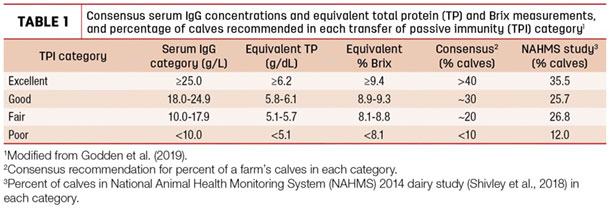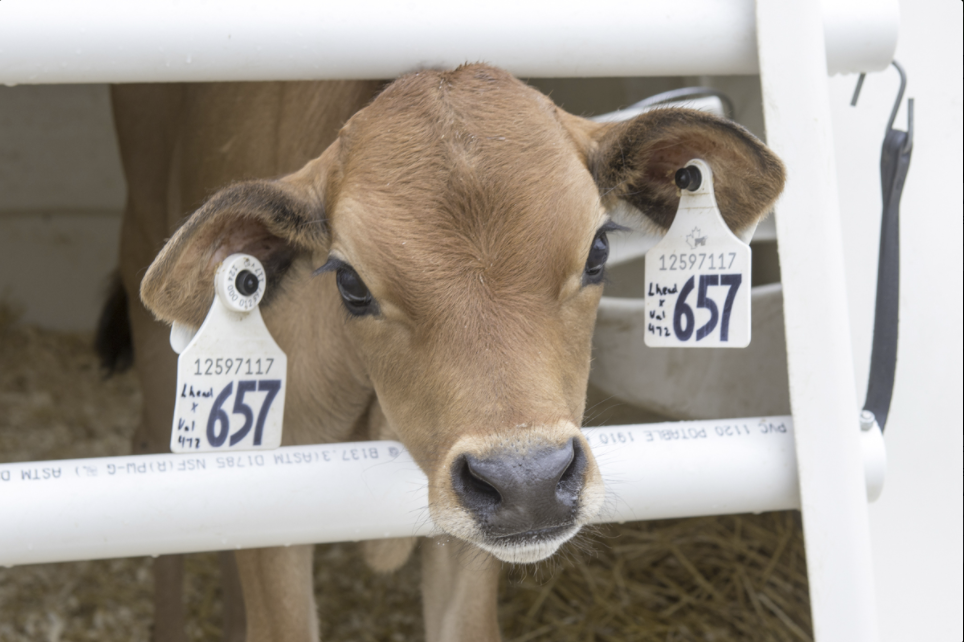“Consensus recommendations on calf- and herd-level passive immunity in dairy calves in the United States.”
Journal of Dairy Science, Vol. 103 No. 8, 2020.
This article, written by experts from several American and Canadian universities and companies, provides new guidelines to assess passive immunity in calves. It also provides colostral management recommendations to meet the new standards.
Passive immunity in calves is evaluated by measuring serum or plasma immunoglobulin G (IgG) or serum total protein within the first 7 days of age. The current individual calf standard for categorizing dairy calves with successful passive transfer or failure of passive transfer of immunity is based on serum IgG concentrations of greater than or equal to 10, and less than 10 grams per litre, respectively.
Although this criterion has helped to improve calf mortality rates since 1991, surveys carried out by the USDA show the percentage of calves with morbidity events has not changed over the same time. The 2014 USDA Animal Health Monitoring System study showed that almost 90% of calves sampled had successful passive immunity, based on the standard indicated above. The question is: If calves have enough passive immunity, why aren’t morbidity events improving?
The authors evaluated several sources of information and discussion, including aspects related to the beef industry as well as how achievable these new recommendations are on practical farms, to propose new transfer of passive immunity standards. The proposed standard (the authors assume that IgG is measured at 24 to 48 hours after birth) include four serum IgG categories: excellent, good, fair and poor, with serum IgG levels of greater than or equal to 25.0, 18.0 to 24.9, 10.0 to 17.9 and less than 10 grams per litre. At the herd level, it is proposed that greater than 40%, 30%, 20% and less than 10% of calves are in the excellent, good, fair and poor transfer of passive immunity categories, respectively. Implementation of the proposed standard should further reduce the risk of both mortality and morbidity in newborn calves.
They also indicate that achieving these levels of calf serum IgG requires provision of high-quality colostrum promptly after birth. Based on the survey, the farms that achieved this did it either by feeding a single feeding of colostrum at approximately 2 hours after birth, delivering approximately 300 grams of IgG (colostrum), or alternatively by feeding multiple colostrum feedings and delivering approximately 400 grams of total IgG in the first 24 hours (currently the recommendations are to deliver 150 to 200 grams of immunoglobulin in the first colostrum “meal”).
Because assessing serum IgG concentration is not easy to do on-farm, the authors indicate the equivalent recommendation in terms of total protein concentration as well as Brix measurements (Table 1).

Note: Brix in Table 1 is evaluated in the serum, not in the colostrum.
“Investigation of weaning strategy and solid feed location for dairy calves individually fed with an automated milk feeding system.”
Journal of Dairy Science, Vol. 103 No. 7, 2020.
This article, written by researchers from the University of Guelph, investigates the effect of two gradual weaning programs and the location of the distribution of solid feed within individual calf pens, in different parameters: feed intake, growth and behaviour of calves fed milk by an automated milk feeder.
Feeding calves more milk comes with the challenge of encouraging solid feed consumption early in life, especially before weaning. Research shows gradual weaning programs will encourage greater solid feed consumption compared with abrupt weaning, but the authors say it is difficult to implement these gradual weaning programs through manual feeding methods; however, automated milk feeding systems (AMF) for calves have made these programs easier to implement. Research about this topic has mainly concentrated in comparing abrupt versus gradual weaning, so one of this study’s objectives was to evaluate which gradual weaning program is better for weaning calves off high levels of milk.
The authors elaborate that calves are naturally gradually weaned over a long period of time when raised with their dam, so they predict that small, frequent reductions in milk would be a more natural weaning process than reducing milk in larger quantities in a step-wise weaning program.
Another aspect of interest, the authors refer, is that cattle are naturally grazing animals, with specific spatial memories, meaning they will associate particular locations with the quality of feed available, so this study wanted to determine if calves may associate a particular location within their pen with where they can consume their preferred feed source: milk. If calves can associate a particular location with consuming the preferred milk, there is potential that placing their solid feed close to this location will help encourage solid feed consumption pre-weaning and weaning, as they would associate that location with consuming quality feed sources.
For the study, 60 female calves were randomly assigned to one of two weaning treatments (continuous gradual weaning program or multi-step gradual weaning program) and one of two solid feed placement treatments (solid feed placed either at the front of the pen, adjacent [ADJ] to the AMF, or at the back of the pen on the opposite side from where the milk was offered [OPP]).
The difference between the continuous gradual (CG) weaning and the multi-step (MG) program was that calves assigned to the CG treatment had their milk allocation reduced in small, equal increments from 12.5 litres per day on day 43 to 2 litres per day on day 56. Calves assigned to the MG treatment were offered 10 litres per day on days 43 to 45, 8 litres per day on days 46 to 49, 6 litres per day on days 50 to 52 and 3 litres per day on days 53 to 56.
Overall, the results indicate that both gradual weaning treatments resulted in similar performance and behaviour. However, placement of solid feed next to the milk source was demonstrated to increase feed, water and milk intake during the pre-weaning stage, contributing to greater growth. In fact, the ADJ calves spent more time consuming solid feed during the 10-week period. The ADJ treatment calves had 10% greater average daily gain compared with OPP treatment calves during the pre-weaning phase.
This column brings you information regarding some of the research being done around the world and published in the Journal of Dairy Science. The objective is to bring to light areas of research that may have an immediate practical application on a dairy farm, as well as research that, even though may not have a practical impact now, could be interesting for its future potential application. The idea is to give a brief overview of select research studies, but not go into detail on each topic. Those interested in further in-depth reading can use the citations to find each study.










